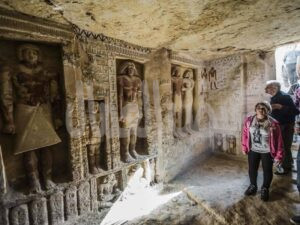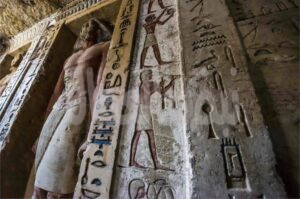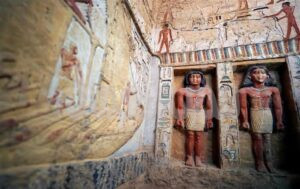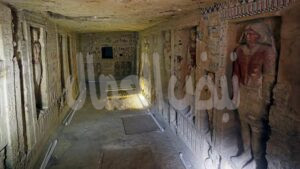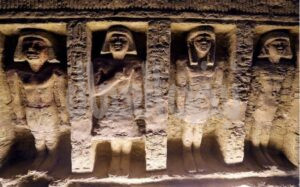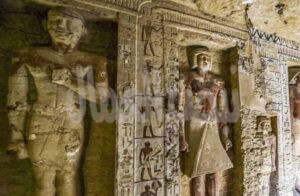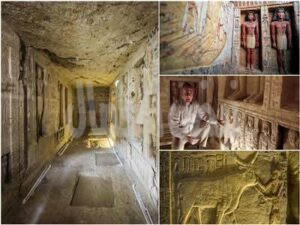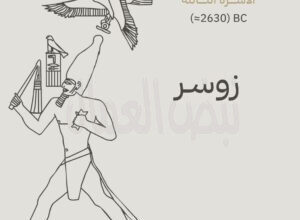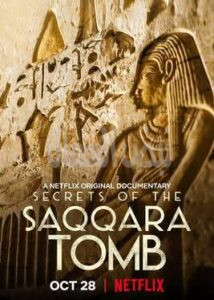
محمد عبدالرحمن
٨ نوفمبر ٢٠٢٥
مقبرة واح تي هي اكتشاف أثري بارز في منطقة سقارة بمصر، وتعود إلى عصر الأسرة الخامسة في الدولة القديمة (حوالي 2500 قبل الميلاد).
(معلومات أساسية عن المقبرة:)
الموقع: تقع في منطقة سقارة الأثرية، شمال غرب هرم زوسر المدرج.
تاريخ الاكتشاف: تم الكشف عنها في أواخر عام 2018 بواسطة بعثة أثرية مصرية برئاسة الدكتور مصطفى وزيري، الأمين العام للمجلس الأعلى للآثار.
صاحب المقبرة: تعود لشخص يُدعى “واح تي” (Wahtye)، وكان كاهنًا رفيع المستوى وكبير الموظفين في البلاط الملكي خلال عهد الملك نفر إير كا رع.
الأهمية: تعتبر واحدة من أروع وأغنى المقابر المكتشفة مؤخرًا في سقارة، وقد وُصفت بأنها “كنز كبير”.
(محتويات وميزات المقبرة:)
الحالة العامة: المقبرة في حالة حفظ ممتازة، خاصة النقوش والألوان الزاهية التي صمدت لآلاف السنين.
التصميم والنقوش: تتكون المقبرة من بهو أعمدة وغرف متتالية تنتهي بغرفة الدفن. جدرانها مزينة بشكل مكثف بمناظر تصور الحياة اليومية في مصر القديمة، بما في ذلك مشاهد الصيد، والزراعة، وصناعة الفخار، وتقديم القرابين، ما يوفر نظرة ثاقبة للحياة آنذاك.
تماثيل: عُثر بداخلها على العشرات من التماثيل الصغيرة الملونة، بما في ذلك تماثيل لواح تي وعائلته، مما يعكس مكانته الاجتماعية والدينية الهامة.
الأبواب الوهمية: تحتوي المقبرة على أبواب وهمية، كانت تعتبر في المعتقد المصري القديم ممرات للروح (كا) للتنقل بين عالم الأحياء وعالم الآخرة.
الفيلم الوثائقي: حظي اكتشاف المقبرة باهتمام إعلامي كبير، وتم إنتاج فيلم وثائقي بعنوان “أسرار مقبرة سقارة” (Secrets of the Saqqara Tomb) الذي عرض على منصة نتفليكس في عام 2020، ويتتبع قصة اكتشافها وفريق العمل الأثري.
تُعد مقبرة واح تي نموذجاً فريداً للمقابر الخاصة بكبار النبلاء في الدولة القديمة، وتسلط الضوء على عظمة الحضارة المصرية القديمة وتفاصيل حياتهم اليومية ومعتقداتهم الجنائزية.
The Tomb of Wahtye is a significant archaeological discovery in the Saqqara necropolis of Egypt, dating back to the Fifth Dynasty of the Old Kingdom (circa 2500 BC).
(Background Information about the Tomb:)
Location: It is located in the Saqqara necropolis, northwest of the Step Pyramid of Djoser.
Date of Discovery: It was discovered in late 2018 by an Egyptian archaeological mission headed by Dr. Mostafa Waziri, Secretary-General of the Supreme Council of Antiquities.
Tomb Owner: It belonged to a man named Wahtye, a high-ranking priest and chief official in the royal court during the reign of King Neferirkare.
Importance: It is considered one of the most magnificent and richest tombs recently discovered in Saqqara and has been described as a “great treasure.”
(Tomb Contents and Features:)
General Condition: The tomb is in an excellent state of preservation, especially the inscriptions and vibrant colors that have survived for thousands of years.
Design and Inscriptions: The tomb consists of a columned hall and successive chambers culminating in the burial chamber. Its walls are richly decorated with scenes depicting daily life in ancient Egypt, including hunting, farming, pottery making, and offerings, providing a glimpse into life at that time.
Statues: Dozens of small, painted statues were found inside, including statues of Luwahti and his family, reflecting his important social and religious status.
False Doors: The tomb contains false doors, which in ancient Egyptian belief were considered passageways for the soul (ka) to travel between the world of the living and the afterlife.
Documentary: The discovery of the tomb garnered significant media attention, and a documentary film titled “Secrets of the Saqqara Tomb,” released on Netflix in 2020, chronicles the story of its discovery and the archaeological team.
The tomb of Wahtye is a unique example of the tombs of the great nobility of the Old Kingdom, highlighting the grandeur of ancient Egyptian civilization and the details of their daily lives and funerary beliefs.
